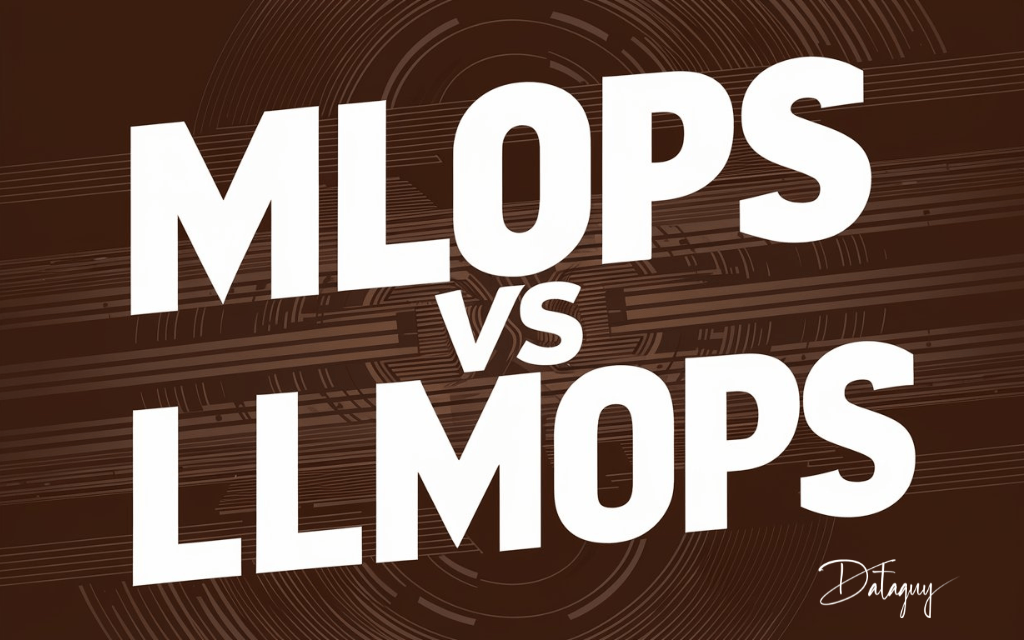Insights Index
ToggleLLMOps vs MLOps: Navigating AI Operations in the Age of Large Language Models (LLMs)
As AI continues to transform industries, understanding how to manage different types of models is crucial. This blog explores LLMOps and MLOps, two essential frameworks for operationalizing AI models. From data collection to continuous integration and deployment, learn how these practices ensure efficiency, scalability, and security in AI projects.

Introduction to MLOps and LLMOps
Machine Learning Operations (MLOps) and Large Language Model Operations (LLMOps) represent two fundamental approaches to managing the lifecycle of AI models. While MLOps focuses on traditional machine learning models, LLMOps is tailored specifically for large language models (LLMs) like GPT, which require specialized handling due to their scale and complexity.
What is MLOps?
MLOps combines machine learning with DevOps practices to streamline and automate the end-to-end lifecycle of machine learning models. This includes data collection, model training, deployment, monitoring, and continuous improvement. Key components of MLOps include:
Data Collection and Preparation
MLOps involves gathering and preprocessing data from multiple sources, ensuring it is clean and ready for model training. Feature engineering and data transformation are critical steps in this process. Proper data handling ensures the foundation for accurate and reliable models.
Automated Model Development
MLOps leverages automated pipelines to develop models efficiently. These pipelines handle tasks such as data processing, feature selection, model training, and evaluation. They are designed to be scalable and secure. Automated pipelines enable rapid experimentation and iteration, which are crucial for developing high-quality models.
Continuous Integration and Deployment (CI/CD)
CI/CD practices in MLOps automate the testing, validation, and deployment of models. This ensures models can be updated and deployed quickly, reducing the risk of errors and improving reliability. CI/CD pipelines support seamless integration of new features and bug fixes, enhancing the robustness of deployed models.
Monitoring and Logging
Effective monitoring and logging are essential for maintaining model performance. Tools track model behavior, detect anomalies, and provide insights for debugging and optimization. Continuous monitoring helps identify performance degradation and ensures that models continue to meet the desired standards.
Model Retraining and Feedback Loops
MLOps includes mechanisms for continuous model improvement. Feedback loops incorporate user insights and real-world performance data to refine and enhance models over time. Regular retraining helps models adapt to changing data patterns and maintain accuracy.
What is LLMOps?
LLMOps extends the principles of MLOps to the specific needs of large language models. These models, due to their size and complexity, require additional considerations and tools to manage effectively. Key components of LLMOps include:
Model Fine-tuning and Prompt Engineering
LLMOps involves fine-tuning pre-trained language models for specific tasks using techniques like prompt engineering. Tools such as LangChain and HoneyHive are used to optimize model performance. Fine-tuning enables LLMs to perform specialized tasks with high accuracy, making them versatile for various applications.
Resource Management
Managing the computational resources for LLMs is critical. This includes efficient use of GPUs and parallel computing to handle the large-scale training and inference tasks required by LLMs. Proper resource allocation ensures that LLMs can be trained and deployed cost-effectively.
Data Management
High-quality, diverse datasets are essential for training LLMs. LLMOps emphasizes robust data management practices, including data cleaning, preprocessing, and annotation. Ensuring data quality is crucial for achieving high model performance and generalization.
Scalability and Performance Optimization
LLMOps ensures that models can scale efficiently and maintain performance under heavy loads. This involves optimizing model latency, managing large volumes of data, and ensuring responsive user experiences. Scalability is vital for deploying LLMs in production environments where demand can fluctuate significantly.
Security and Compliance
LLMOps places a strong emphasis on security and compliance, protecting sensitive data, implementing access controls, and adhering to regulatory requirements. Ethical considerations are also crucial in managing LLMs. Ensuring data privacy and model transparency helps build trust with users and stakeholders.
Key Differences Between LLMOps and MLOps
While both LLMOps and MLOps aim to streamline AI model operations, there are several key differences:
Model Complexity and Scale
LLMOps deals with significantly more complex and larger models compared to traditional MLOps. The operational challenges increase with the size and resource demands of LLMs. Handling these models requires advanced infrastructure and expertise.
Specialized Tools and Techniques
LLMOps employs unique tools for prompt engineering and model fine-tuning, which are less common in standard MLOps practices. These tools help optimize the performance of large language models. Techniques like transfer learning and unsupervised pre-training are often used to enhance model capabilities.
Resource Management
While both practices focus on resource optimization, LLMOps places a higher emphasis on managing vast computational resources required for training large language models. Efficient resource allocation is critical to minimize costs and maximize performance.
Monitoring and Maintenance
Continuous monitoring in LLMOps not only tracks model performance but also addresses the specific needs of LLMs, such as prompt analytics and logging. Monitoring tools must handle the unique challenges posed by LLMs, including their sensitivity to input variations.
Risk and Compliance
LLMOps requires rigorous compliance measures due to the scale and sensitivity of the data involved, alongside the ethical considerations unique to LLMs. Ensuring adherence to regulations and ethical guidelines is crucial for maintaining model integrity and public trust.
Benefits of Implementing LLMOps and MLOps
Both LLMOps and MLOps offer significant benefits in AI operations:
Efficiency
Both practices enhance efficiency by automating repetitive tasks, streamlining development processes, and reducing time to deployment. Automation reduces the risk of human error and increases the speed of model iteration.
Scalability
LLMOps and MLOps ensure that AI models can scale effectively, handling increased loads and maintaining performance across various environments. Scalability is essential for meeting the growing demands of AI applications.
Risk Reduction
By incorporating advanced security measures and compliance protocols, both practices help mitigate risks associated with AI operations. Risk reduction strategies include data encryption, access controls, and regular audits.
Performance Optimization
Continuous monitoring and feedback loops enable ongoing performance improvements, ensuring models deliver optimal results. Performance optimization involves fine-tuning hyperparameters and regularly updating models based on new data.
Case Studies and Real-World Applications
Many organizations have successfully implemented MLOps and LLMOps to enhance their AI capabilities. For instance, a leading e-commerce company used MLOps to streamline its recommendation system, resulting in a 20% increase in sales. Similarly, a healthcare provider implemented LLMOps to develop an advanced diagnostic tool, improving patient outcomes and operational efficiency.
Conclusion
In conclusion, both LLMOps and MLOps are pivotal in the realm of AI operations. While MLOps provides a robust framework for traditional machine learning (ML) models, LLMOps addresses the unique needs of large language models, ensuring they perform optimally and securely. By adopting these practices, organizations can enhance their AI capabilities, drive innovation, and stay ahead in the competitive AI landscape.
Understanding and implementing the right operational practices will not only streamline AI workflows but also unlock new potentials for AI applications in various industries. Embrace the future of AI with confidence, equipped with the knowledge of LLMOps and MLOps.



